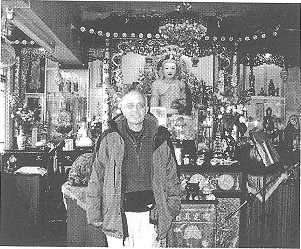 |
The author at the Hong Kong Buddhist Lecture Hall.
作者攝於香港「佛教講堂」 |
每一天的每一刻,上人都在以身示範,教我們如何做個菩薩。他不只是個理論性的模範,還是個真正、活生生、有血肉的人;他的慈悲與明達,完全改善了我自己、我家人,和其他無數眾生的人生。
即使在他涅槃十年後的此刻,我對於「他是誰」的看法,仍然沒有放下;也沒有忘懷我所喜愛的他的形相──不論記在心中,或掛在家中的牆上。但這並非我還未放下對他的執著,因為無論他過去或現在真正的內在,是任過去或現在的誰也無法企及的。當然,他體現與教授的「法」是另當別論──登此「法船」,可載我們到「彼岸」。
初見上人後數月,一天晚上,和他在一起打坐;他以佛光注照我,由我內心之最深處向外伸展。佛光之強,一時間,粉碎了一切我過去到那一刻所認定的「自我」,而接觸到「本我」──那個不受自我、我執或任何界線所約束的自性。可惜那個經驗只有剎那;但個中滋味,已足使我發長遠心,身在世上而能重歸究竟的寶所──這旅程重於一切,縱須多生才能抵達。就在那經驗之後,上人坐在三藩市貧民窟邊塌樓內的舊沙發上打坐,當我看著他時,這個念頭剎時閃現:他真像佛啊!為什麼是佛呢?因為此刻我感覺他現在除了空與光之外,是別無一物,至寂至寧。我當下篤定無疑:他!就是我的師父!
數日後,坐在他樓房前的階梯上,我驚異於這一事實:在這個國家,除了少數虔誠的華人弟子外,有誰認識真正的他,是何許人物呢?較之古代佛教世界,凡是開悟大師,都被視為國寶而廣受尊崇;今日社會之價值觀,何異是天壤之別!
我們旅遊中的高潮與印象
今年三月,內人瑤仙和我參加了劉譚果式居士舉辦的朝聖之旅,去參訪幾處有關上人生平,和傳他法的禪宗祖師虛老的重要地方。我們一行十四人,多數是上人弟子;我們聽過、讀過許多他的事蹟已有多年,終於有這個好機會,與上人傳記中這些不可思議、神話般事蹟,實地結合起來。有時,我們還能聽果式居士談種種事跡──那是她在香港時,成長於上人身邊,所目睹的第一手經歷。
以下是我參訪上人過去幾處住所的印象。
東 北
我們搭乘巴士,由哈爾濱往南,到了上人長大的小村。它是偏居於一片大平原的鄉下,耕地四通八達,一望無際;只有稀疏的樹木,並沒有山丘。我們在三月底到達,日常最高溫是華氏廿幾度;即使是出太陽的日子,又穿著很多件高科技製成的冬衣,我還是感覺凜冽寒風,吹越田野,穿心透骨。我們看見成堆的高粱稈,疊放田邊,令我想到當年上人在亡母墓旁打坐時,只穿著三層布衣;際此季候,那用高粱稈架起的小茅廬,曾經給過什麼樣微不足道的保護!我憬悟到上人經歷過多少不可思議的艱難,而如此難以置信的苦修程度與決心,仍有待我效法!上人的一個姪孫指出那些年上人廬墓打坐的大概地點,大約離村子有一里半之遠。現在墓已不在,老宅子也不見了,「三緣寺」在往北一小時車程處,更是杳無蹤影。那兒已然不再留有上人住過的痕跡;但,少數人還記得他,更多的人只是聽聞過他,且都以他是東北人為榮。
香 港
觀音洞 離開中國大陸抵達香港不久,上人就到「觀音洞」內住。儘管洞的內部在上人離開後經過大事整修,從其格局,仍然不難想見當年多貧苦、多窄小、所能蔭庇的多有限!當時無牆無門,而且後方洞頂仍有個大窟窿,風雨仍可貫入。在那裡,我們見到的人都沒聽說過上人,也沒有相關資料,或任何具體的遺跡,顯示過去他曾住過那兒。
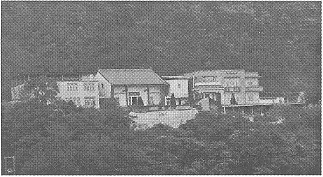 |
慈興寺 Cixing Monastery on Lantao Island, Hong Kong |
在香港大嶼山,上人一手興蓋的「慈興寺」,原是建於一塊別人捐贈的土地上;原有的古廟殘跡還在,旁邊的房舍已整合成為寺院的右翼。下了巴士,到廟上還需步行一個半小時,幾乎全是上坡路,令我吃不消;不過現在一條新路已完工,使原來約四小時的路程大幅縮短。果式居士告訴我們:上人當初常常親自三步一拜,全程拜上山;他的虔誠,使當地工人深受感動,而發心幫忙建廟。此刻我有了新的瞭解,為什麼這項興建工程使上人頭髮都變白了。該廟建好後,上人常常在那裡打禪七。我們到廟上,聽駐錫的法師講法,知道他們每月舉辦一次禪七。那裡很安靜,很少干擾。當然,即使需要攀登「慈興寺」上面的陡階,才能真正親自一睹上人親手雕塑而置於寺頂山岩上的龍,這也是好棒啊!
香港佛教講堂
香港佛教講堂位於香港市中心,在跑馬地對面一座不起眼的建築物的11樓。這個公寓又小又普通,可是當我走進門,我感到被那裡的能量所震撼,這勝過我在中國其他任何地方所經驗到的。它和之前我在上人住處常感受到的,有著相同的品質:清晰、靜謐、充滿生機,而且感應喜樂。我感覺我回到家了!
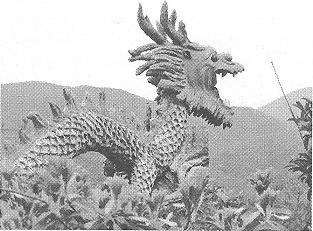 |
此龍安在廟的上方,是上人的手藝。
The dragon located above the monastery, which was fashioned by the Venerable Master. |
新機會
對於當今中國複雜的政治局勢如何影響到佛教的修行,個人不敢說很有多瞭解;所能報告的是,的確曾見一些寺院供奉著上人的德相,也有人自己自行出版他的法語。一些僧眾告訴我們,他們讀過上人的開示,敬仰他,也為他對今日中國佛教的影響喝采。有的指出:現在雖然還不普遍,但確有新機會公開講佛經,而且邀請我們的法師去講法。我們到處見到主要寺廟在翻修,也聽說寺僧生活在改革。希望這些正面的發展能繼續,並且希望「法總」的僧眾在不久的未來,有機會在中國參與正法再播種的工作。
|
|
In every moment of every day, the Venerable Master showed us by his example how to be a Bodhisattva. He was more than an abstract model; he was a down-to-earth, living, breathing person of compassion and clarity that radically changed for the better my life, those of my family, and those of countless other beings.
Even now, ten years after his nirvana, I still have not let go of my preconceptions of who he was; I have not let go of my beloved images of him—both in my mind and on the walls of my home. Yet it is not that I have not let go of him. Because in what was and is truly him, there was and is nothing that one could possibly grasp and hold on to. Except of course the Dharma that he embodied and taught, the Dharma that is ‘like unto a raft’ that can take us to the ‘other shore.’
Several months after first meeting him, while meditating with him one evening, he infused me, from my deepest inside outward, with the light of the Buddha, so strong that it temporarily obliterated what I had until then thought to be me, bringing me in touch with the real me, my true nature unfettered by individuality, ego-attachment, and any kind of boundaries. Unfortunately the experience was only temporary, but that taste was enough for me to resolve to make my way back permanently to that ultimately precious way of being in the world, a journey which is more important than anything else, even if it takes me many lifetimes to arrive. Right after that experience, when I looked at him, as he meditated on an old sofa, in a dilapidated building, on the edge of a San Francisco slum, these thoughts spontaneously arose in my mind. ‘He looks like a Buddha. Why a Buddha? Because I am experiencing him right now as empty; I can see nothing inside him but emptiness and light, utter stillness and peace.” At that moment I knew with complete certainty that he was my teacher.
A few days later, while sitting on the front steps of his building, I marveled at the fact that in this country, with the exception of a handful of devout Chinese disciples, he was unknown in the sense that no one recognized who he really was. What different values our contemporary society now has, compared to those of the ancient Buddhist world that widely honored the great enlightened masters and considered them national treasures!
Highlights of Our Trip
In March of this year my wife Yausen and I went on a pilgrimage tour, arranged by Madalena Tam Lew (Upasika Guoshi), to important places connected with lives of the Venerable Master and his lineage predecessor Chan Patriarch Xuyun. There were fourteen of us, mostly disciples of the Venerable Master. Having heard and read about the stories of his life for so many years, we had a wonderful opportunity to tie the incredible, myth-like events related in his biography to actual places, and in some cases to hear first hand from Upasika Guoshi about the events she had personally witnessed while she was growing up around the Master in Hong Kong.
Here are some of my impressions from our visits to places the Master had lived.
Dongbei
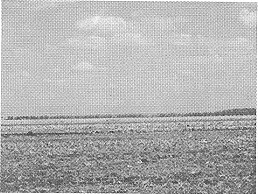 |
A view of the countryside near the village where the Venerable Master grew up.
上人生長之村落附近一瞥 |
We took a bus south of Harbin to the small village where the Venerable Master grew up. It is out in the countryside on a completely flat plain, with cultivated land stretching every direction to the horizon. There are a few trees and no hills. We were there at the end of March, and the daily high temperature was in the low 20s. Even with the sun out, and many layers of high-tech winter clothing, I felt the strong, freezing wind that blew across the fields chill me to the bone. We saw stacks of sorghum stalks piled up by the side of the fields, and I thought of the Venerable Master sitting there by the side of his mother’s grave, with only three layers of cloth clothing, and of the inadequate protection from the weather that his crude hut of sorghum stalks must have provided. I realized how incredibly difficult it must have been for him and how inconceivable that degree of ascetic practice and resolve still is to me. A grandnephew of the Venerable Master pointed out to us the general location of the grave in a field, perhaps a half a mile from his village, where the Venerable Master meditated during those years. The grave is gone; his family’s house is gone; Three Conditions Monastery, about an hour’s drive to the north, is gone. There is no physical trace left of his presence there. Yet some people still remember him, more have heard of him, and they are proud that he is from Dongbei.
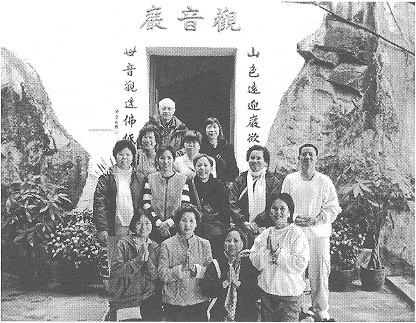 |
The travel group in front of Guanyin Cave (photo by John Hall)
旅行團攝於「觀音洞」前(約翰賀爾攝) |
Guanyin Cave
Soon after the Venerable Master arrived in Hong Kong from mainland China, he went to live in Guanyin Cave. Although the cave was extensively remodeled after the Venerable Master left there, we could see how stark it must have been, how small, and how little shelter from the elements it afforded. There was no wall and door then, and in the top back of the cave there is still a large opening through which the wind and rain can still enter. The people we encountered there knew nothing of the Venerable Master, and there is no information available about him there or any physical indication that he had lived there.
Cixing Monastery
Cixing Monastery on Lantao Island was built by the Venerable Master on donated land that contained the ruins of an ancient Buddhist monastery. The villa that was on the land was integrated into the right hand side of the monastery complex. It was a tough hike for me of about an hour and a half, almost all uphill, to get from where our bus last left us off to go the monastery. Yet there is a new path now, and the time it takes now is considerably less than the approximately 4 hours that it originally took. Upasika Guoshi told us that the Venerable Master initially often made the journey doing three steps and one bow the whole way up. In that way he endeavored to move the hearts of the local workers, so they would agree to help build the monastery. I now have a new appreciation of why the project temporarily turned the Venerable Master’s hair gray. After the monastery was completed, the Venerable Master often held Chan meditation sessions there. When we got to the monastery, we heard Dharma talks from the monks in residence and learned that they do a week of Chan every month. It is quiet there, and there are few distractions. Of course it was also wonderful to actually see in person the dragon that the Venerable Master had sculpted on the rocks above the monastery, even though it entailed an additional steep climb.
Hong Kong Buddhist Lecture Hall
The Hong Kong Buddhist lecture hall is located on the 11th floor of a nondescript apartment building in downtown Hong Kong, across from the racetrack. The apartment in which it is located is rather small and ordinary, but when I walked through the door I felt overwhelmed by the power of the energy there. It was stronger than I experienced anywhere else in China. And it had the same qualities that I had previously often felt in the presence of the Venerable Master; it was clear, still, invigorating, and joy-inducing. I felt that I had come home.
New Opportunities
I don’t claim to understand clearly how the complicated political situation in China today affects the practice of Buddhism there. I can report that we did find the Venerable Master’s photo displayed in some monasteries, and that people are publishing some of his teachings on their own. Some monks told us that they had read his Dharma talks, revere him, and applaud his influence on the current course of Chinese Buddhism. Some indicated that there are new opportunities for giving public lectures on the Buddhist sutras, though such events are still uncommon, and asked that we send Dharma masters there to teach. All over we saw major temples being refurbished and were told that monastic life in them is being reformed somewhat. I hope that these positive developments will be sustained, and that there will soon be opportunities for the Dharma Realm Buddhist Association’s Sangha to participate in the replanting of the seeds of the right Dharma in China.
|